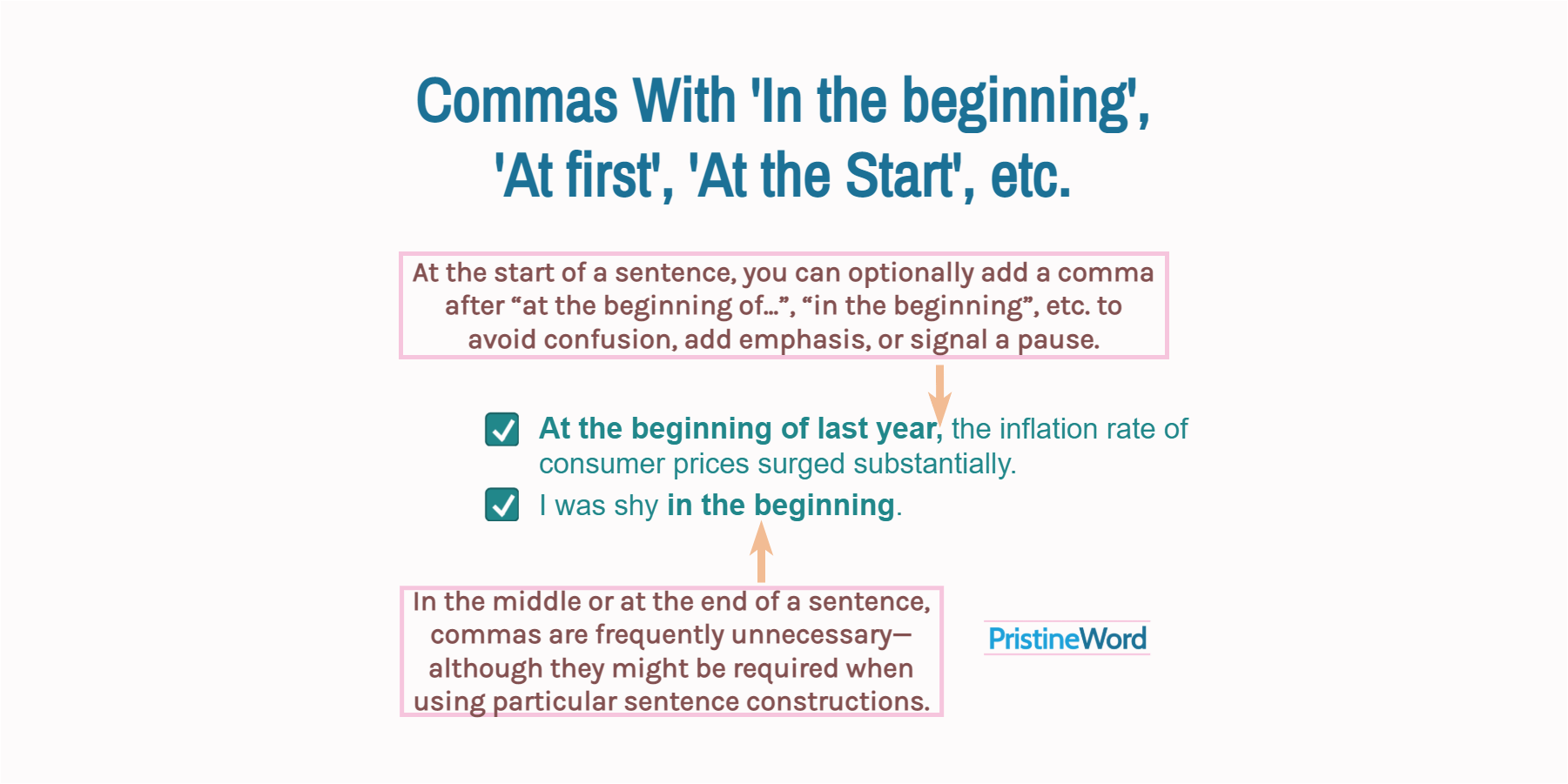At the start of a sentence, you can optionally add a comma after “at the beginning of...”, “at the start of...”, “in the beginning”, or “at first” to avoid confusion, add emphasis, or signal a pause. In case of doubt, use it to help readers understand the meaning of the sentence.
At the start of a sentence, you can optionally add a comma after “at the beginning of...”, “at the start of...”, “in the beginning”, or “at first” to avoid confusion, add emphasis, or signal a pause. In case of doubt, use it to help readers understand the meaning of the sentence.
At the beginning of last year, the inflation rate of consumer prices surged substantially.
In the middle or at the end of a sentence, commas are frequently unnecessary with these phrases—although they might be required when using certain sentence constructions.
I was shy in the beginning.
Contents
1. Differences Between ‘At the Beginning’ and ‘In the Beginning’
- “At the beginning” or “at the start” are used to refer to the first part of something. These prepositional phrases are typically followed by “of” (e.g., “At the beginning of the book, the good guy gets shot.”)
- “In the beginning”, “at first”, or “initially” are used to show contrast; for example, you can use them to express that something started out some way, but it changed later. They are not usually followed by “of” (e.g., “In the beginning, I found Spanish difficult. Now I feel confident using it.”)
2. When to Use Commas With ‘At the Beginning’, ‘In the Beginning’, etc.
2.1 At the Beginning of a Sentence
In general, a comma is not required after short introductory phrases, such as “at the beginning”, “at the start”, “in the beginning”, or “at first”.
At first I didn’t believe him.
In the beginning human beings hunted to live.
But you can optionally use it to clarify or add emphasis.
In the beginning, computers were meant to be used only for calculations.
Add also a comma if the introductory phrase is followed by a subordinating clause.
In the beginning, when love is a promise and attraction is a feeling, romantic relationships are great.
“At the beginning”, “at the start”, etc. may be followed by another prepositional phrase; for example, we can say “at the beginning of the story”, “at the start of the book”, etc.
At the beginning of the last century, the First World War was ignited by the assassination of the Austro-Hungarian Empire's heir to the throne.
In such a situation, we usually add a comma after long introductory phrases (five or more words).
At the beginning of the year, commodities prices went up dramatically.
However, if the introductory phrase begins with a preposition and is clear, the comma may not be necessary even if the phrase contains five or more words.(1)
At the beginning of the month I started learning Japanese.
In case of doubt, use a comma since it will probably help readers understand the meaning of the sentence.
At first, Olivia resisted and said no to him because she didn’t know what to say.
Be aware, on the other hand, that phrases of similar importance should be separated by commas.
At the beginning of the story, in Northern Europe, a man named John Sobieski assumed the throne.
Note that in the example above we can either say:
- “At the beginning of the story, in Northern Europe, a man...”, or
- “In Northern Europe, at the beginning of the story, a man...”
Since these phrases are of similar significance, we can swap them around (or put an “and” between them), so we need a comma.
By contrast, we do not use a comma between two cumulative phrases (for example, “at the beginning” and “of the story” in the sentence above) because they are not of equal importance (the second describes the first). In other words, you cannot swap them around, and you cannot put the word “and” between them.
Recommended: Do you need a comma after "in the end" or "at the end"?
2.2 In the Middle or at the End of a Sentence
In the middle or at the end of a sentence, we do not usually add commas to set off adverbial prepositional phrases, such as “at the beginning of...”, “at the start of...”, “in the beginning”, or “at first”.
My children are at the beginning of their formal education.
My children are, at the beginning of their formal education.
But there are particular constructions where commas may be required to:
- avoid confusion,
- separate a series of coordinate phrases or clauses,
- insert parenthetical information, or
- introduce an independent clause after a conjunction.
Leslie Nielsen was my favorite actor of the movie Airplane, at the beginning of the 1980s, because he was convincing of his part in the play.
Rebecca was really shy at first, but that's just until you get to know her.
You can follow the same comma guidelines when deciding whether to use a comma after the phrase "in the middle of...".
3. References
(1) Kaufman, Lester; Straus, Jane. The Blue Book of Grammar and Punctuation. Chapter 2 (punctuation).

